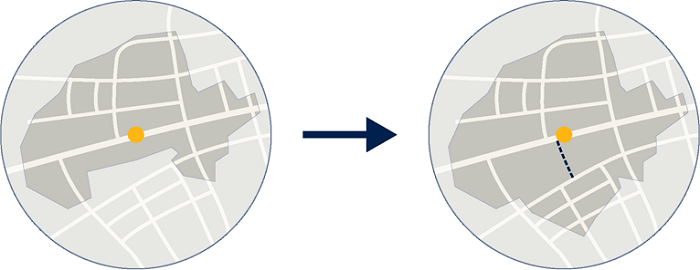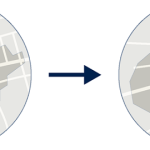According to research in pedestrian behaviour, the prioritisation of pedestrian access to public transport can increase the amount of passengers. Therefore, Movia seeks to strengthen the interaction between pedestrians and public transport in collaboration with municipalities.
90 percent of public transport users reach bus stops by foot. In addition, almost half of the total travelling time is spent walking. Walking seems to be the most convenient option to reach bus stops, which highlights the need to prioritise pedestrian access to bus stops, train and metro stations.
Furthermore, our surroundings affects our behaviour: people are willing to walk longer distances to bus stops if they are easily accessible and the route feels safe. This is the result from research by Helge Hillnhütter who studied the behaviour of pedestrians. His research shows that public transport users are willing to walk up to 70 percent longer distances in pedestrian-oriented urban areas (Hillnhüt-ter, 2016). Theoretically, this can increase the catchment area by three times. If we can achieve just a part of this huge potential, it will have substantial effects on the use of public transport. Furthermore, prioritisation of pedestrians will positively impact health, environment and urban life.
New analytical tools can support the prioritisation of pedestrians
As a way to prioritise pedestrians, Movia has adopted a new approach when considering pedestrian access. Through the use of GIS tools it is possible to analyse the catchment area based on distance in the actual network of footpaths rather than on distance as the crow flies. By comparing both meth-ods, it is relatively easy to point out locations where pedestrian access can be improved. Among the possible improvements are relocation of bus stops, creation of new footh paths, breakthrough in fences or hedges etc. Solutions that are applicable not just in cities, but also in more sparsely popu-lated areas.
Additionally, there is a potential in improving the urban layout near bus stops through an urban design that encourages people to walk. Examples of this are convenient and safe road crossings to avoid detours, good access to facilities like shopping opportunities in close distance to bus stops as well as pleasant and stimulating urban surroundings.

Collaboration with municipalities
The new approach is tested in a collaboration between Movia and the City of Copenhagen, who is currently working to adopt a specific goal for the interaction between pedestrians and public transport in the future municipal plan. The collaboration has led to suggestions for several physical improve-ments along a central bus route: creation of new shortcuts for pedestrians; improvement of road crossings; improvement of access from bus to metro etc.
Other municipalities already incorporate both urban design and footpath networks when planning for new and existing urban areas. Building upon this it is possible to strengthen the interaction between pedestrians and public transport. Therefore, Movia is now, in collaboration with municipalities, work-ing to adopt the new approach as part of public transport planning in both urban areas as well as in more sparsely populated areas.
For information: Mrs Marie Vang Nielsen
